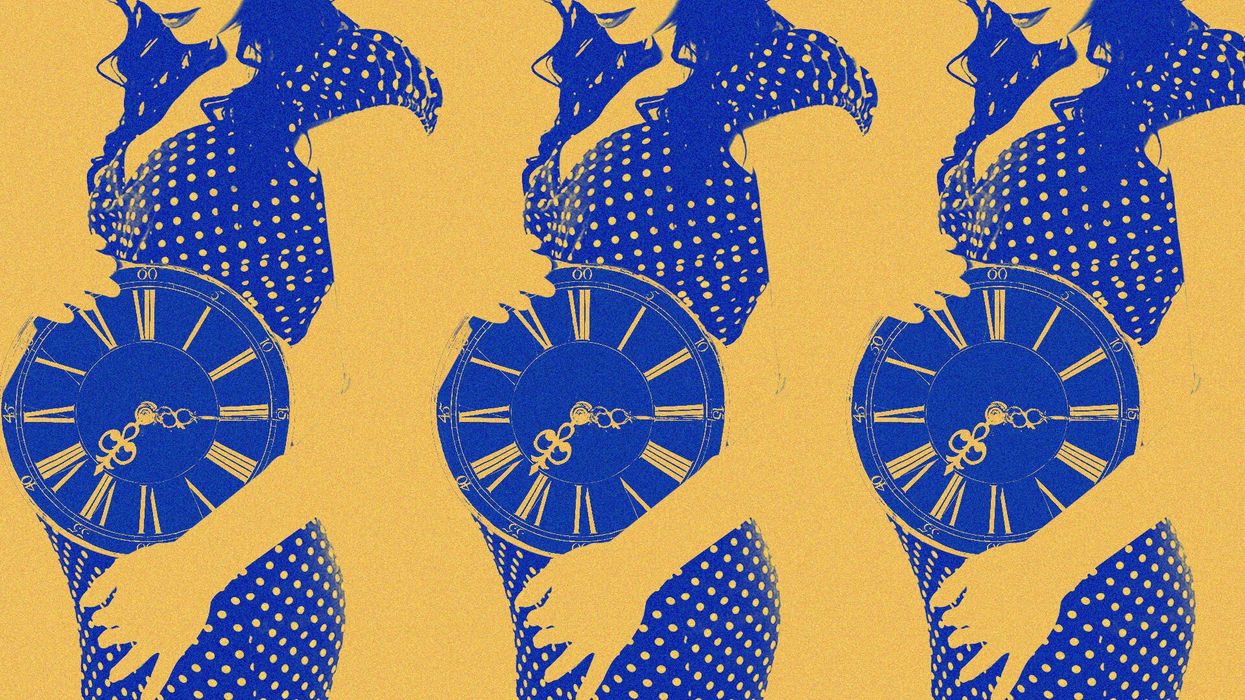The $19,000 Reality of Freezing Your Eggs
One writer on her decision to undergo the process at 35 despite having a long-term partner.

Four months ago while laying under a beach umbrella on vacation with my best friend in Mexico, a complete stranger walked up to us and asked if I was okay. I was reading a book called Regretting Motherhood, recommended by my friend Jordan, who is also child-free. A liter-sized bottle of what looked like tequila—it was sparkling water—sat beside my beach chair. I was two weeks past my initial egg-freezing consultation, and despite my wishy-washy stance on parenthood, I knew I was going to do it. I just wasn’t sure about the rest of it.
My partner and I have been together for more than three years and though I just turned 35, he’s just nearing 30 and we’re just not ready to decide on, let alone have, kids yet. Both of us come from Italian families with inquiring minds, so holidays and get-togethers often meant we’d be pressured to talk about our plans for reproduction. Friends, family, and strangers always told me, often with a hint of condescension, that I’d “just know” or it’d “just happen.” (It hasn’t.) We figured freezing my eggs wouldn’t just be an insurance plan for later, but it’d also take the pressure off us to plan our lives according to my biological clock—and it’d get my aunts off our back. I’d started looking into it again last year, two years after being told at an NYC clinic-that-shall-not-be-named told me that at 32, I was almost too old.
Like a lot of women, I told myself that because I’d been on the pill for 20 years and because I messed it up so many times and still never been pregnant that I must not be fertile. I actually put off my consultation for so long because I could “come to terms” with my inability to have kids, a fact that I completely fabricated and had conflicting feelings about. At the same time, I’d spent years trying to sort out my views on motherhood, as well as how they mingled with my complicated relationship with my own mother: Did I only think I didn’t want kids because she may not have wanted them? Despite being a co-parent for my nephew, could I ever see myself as truly maternal? It’s a crazy feeling to not know if you want to have kids, but to know fiercely that you want to have the option. Apparently, hoards of women had the same thought—or so I’d find out when I shared my first transvaginal scan on Instagram. We decided to move forward with freezing only my eggs rather than embryos, even though we knew that meant accepting a success rate of about 50 percent rather than 70 percent. I’d later find out from one of my nurses—as well as at least a handful of people in my DMs—that it was mostly single women that went that route.
It’s a crazy feeling to not know if you want to have kids, but to know fiercely that you want to have the option.
At our baseline appointment, my doctor would use a machine with a probe to show me my uterus, ovaries, and yes, egg count—also known as an antral follicle count. She said that for someone my age and health, I could expect to have an average of 10 to 20 follicles. I found out I had 27 follicles—my lucky number—and immediately cried tears of relief on the table. At least we still have a choice. It’s particularly cruel that this easy, two-minute scan isn’t part of a routine gynecological exam from the time you get your first period; it leads to an inordinate amount of fear and anxiety around fertility—which was part of the reason I was doing this in the first place.
During my next appointment, I found out I’d have to undergo another common hurdle: synching my eggs. I had one rogue egg that was much bigger than the rest, and if I’d started injections then, it would likely hog all the hormones and lead to an unsuccessful cycle. To remedy this, my doctor put me on two weeks of estrogen and calculated my next appointment for about two days after I would ovulate. This set us back another month, which meant I’d have to cancel future travel plans.
Plus, the once-daily estrogen pill exhausted me—both physically and emotionally. We forged ahead anyway: A face full of breakouts and a few petty arguments later, I finally got my period and could start the hormone injections, which I somehow thought would be easier than taking a once-daily pill. Not so. Oh, and the bill for my injection medication was $4,962—which wasn’t included in the $12,023 cycle cost, nor were the $650 baseline co-pays—and Blue Shield didn’t cover a cent. Free same-day delivery was supposed to be the silver lining.
I went to my appointment the next day to find out that I had the green light to start my injections. This also meant I’d pay for the rest of the process—daily monitoring, bloodwork, the surgical retrieval, and a five-year storage plan—in full. My doctor and nurses gave us strict instructions on when and how to administer the injections, but there was such a wide margin of error, which, as a Type A person, was terrifying. It was crazy to think that this was all in our hands—mixing the medicine correctly, making sure I take it at the right time and administering the entire injection before I freak out.

My partner and I made a ritual of it: We put on music, started icing my stomach, and got in bed–we found that it was much easier to do if I was laying down. I canceled any plans that would keep me out at injection time—around 9 pm—and tried to get as much sleep as possible while the hormones did their thing. During my cycle, I’d spend nearly every other day back in the office for bloodwork and a transvaginal exam, where a nurse would count and measure the size of each egg. I’d started at 27 follicles and over the course of the two weeks, we kept finding more. Most of them started out around 4mm, and we’d hope for them to quadruple in size, bloating me in the process. It’s a strange feeling to see your stomach bloat and feel happy, or at least relieved.
13 days later with more than 40 follicles and an estrogen level count of 5682 (up from my baseline of 350), I had about 25 mature eggs ready to retrieve. The scary thing is that even with a lot of mature eggs, they’re not often all viable, and I could end up with just a handful. That handful might not survive the defrosting period—or if they do, they may not implant down the line. The ways at which your chances dwindle throughout the process can play mind games with you—and they certainly did with me.
Plus, with so many eggs, I was at high risk of Ovarian Hyperstimulation Syndrome, so while most women can return to work and daily life the day after their surgery, I’d be on bed rest for at least three to five days and stuck eating a strict keto diet as to not overwhelm my ovaries, which are now filled with fluid where the eggs used to be. Things like carbs, twisting, and even mild exercise can cause that fluid to spill into my abdomen and the areas surrounding my lungs and heart, so I ate most of my meals (steak, chicken, and a disgusting amount of bacon) in bed while I binged Indian Matchmaker.
Luckily, we successfully retrieved 31 eggs, and all 31 were viable and frozen. I spent another week hobbling around my apartment, making it out only when completely necessary. Though my partner and I aren’t any closer to figuring out if and when we want kids, we’re relieved to know we’ve got a full soccer team on ice when we’re ready to decide.




